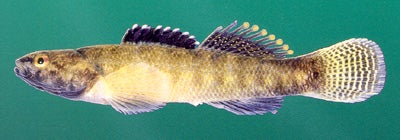LOLLIPOP DARTER
SCIENTIFIC NAME: Etheostoma neopterum
CHARACTERISTICS: The lollipop darter is distinguishable from other members of the subgenus Catonotus in Alabama by the soft dorsal fin morphology of breeding males. In Etheostoma neopterum, each ray in this fin has two branches of equal length tipped with a large yellow knob characteristics of the species. Fin membranes extend only one-half to two-thirds the length of the rays. Two to four rows of small windows appear on each membrane. The caudal fin has eight to 12 yellow and black alternating bands. The spiny dorsal fin is black with a small yellow knob on the tip of each spine. Etheostoma neopterum is similar in appearance to E. crossopterum, E. corona, and E. nigripinne, and nonbreeding individuals are difficult to distinguish. However, E. neopterum does not occur sympatrically with either E. corona or E. nigripinne. The soft dorsal fin morphology of breeding males is sufficient to separate E. neopterum from E. crossopterum, which lacks knobs on the soft dorsal fin.
ADULT SIZE: 1.4 to 2.4 in (35 to 60 mm)
DISTRIBUTION: Etheostoma neopterum has a very restricted range, know only from the Shoal Creek system in northwestern Alabama and south-central Tennessee (Page et al., 1992). The lollipop darter occurs syntopically with the fringed darter, E. crossopterum, also of the subgenus Catonotus, in the Shoal Creek system in Alabama.
HABITAT AND BIOLOGY: The lollipop darter almost exclusively inhabits shallow undercut banks in slow-moving sections of cool, spring-fed, upland streams. Substrates in these areas usually consist of sand or chert covered with leaf litter and detritus. Spawning occurs from late March through April on the undersides of slabrocks, a similar behavior to that in other species of the subgenus Catonotus. Speculation is that the knobs on the spines of most Catonotus species, and the knobs on the soft dorsal rays of the E. neopterum species group in particular, function as egg mimics and stimulate spawning activity in females (Bart and Page, 1991).
ORIGINAL DESCRIPTION: Howell and Dingerkus described the lollipop darter in 1978.
ETYMOLOGY:
Etheostoma means strain mouth, possibly referring to the small mouth.
Neopterum means new fin, referring to the newly observed morphology of the soft dorsal fin.
The copyrighted information above is from Fishes of Alabama and the Mobile Basin.






